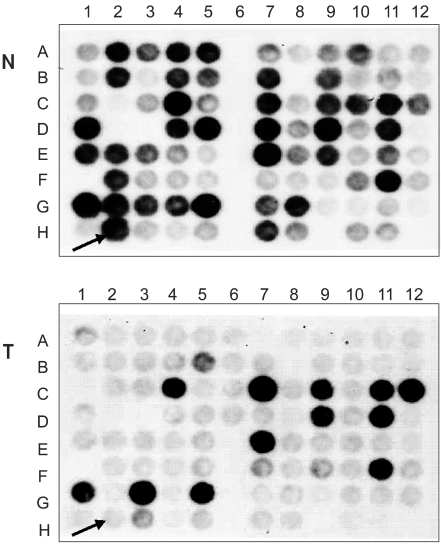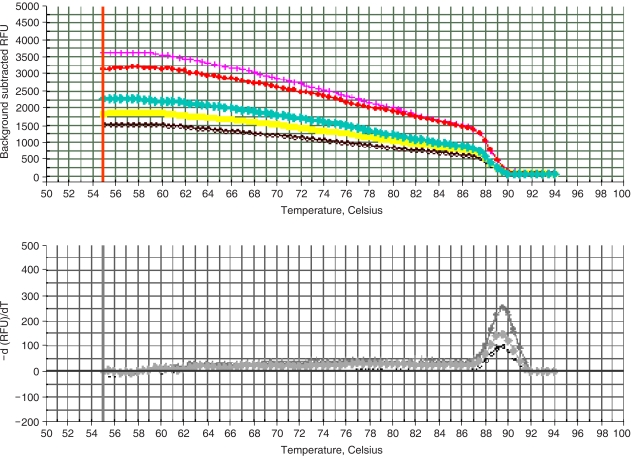Cancer Res Treat.
2004 Aug;36(4):263-270.
Detection of RTP801, a Gene That is Differentially Expressed in Irradiated HeLa Cells
- Affiliations
-
- 1Department of Dermatology, College of Medicine, Chungnam National University, Daejeon, Korea.
- 2Department of Radiation Oncology, College of Medicine, Chungnam National University, Daejeon, Korea. mjcho@cnu.ac.kr
- 3Department of Biology, College of Natural Sciences, Chungnam National University, Daejeon, Korea.
- 4Cancer Research Institute, Chungnam National University, Daejeon, Korea.
Abstract
- PURPOSE
To quantify the effects of irradiation on the expression levels of a differentially expressed gene, RTP801, in HeLa cells. MATERIALS AND METHODS: Total RNA was isolated from irradiated and non-irradiated HeLa cells. A subtraction library was constructed, from which 88 random clones were screened. The expression patterns of one clone, detected by reverse Northern blotting, were quantified by real time RT-PCR, using CYBR green I dye. RESULTS: RTP801, a hypoxia-inducible factor-I-responsive gene, was identified as a differentially expressed gene in HeLa cells exposed to X-ray. Real time RT-PCR showed that the mRNA levels of RTP801 were greatly diminished by radiation. CONCLUSIONS: These results suggest that down-regulation of hypoxia-inducible factor-I-responsive genes, such as RTP801, in irradiated HeLa cells may result in reductions in the radiotherapy resistance of tumor cells.
Keyword
MeSH Terms
Figure
Reference
-
1. Coleman CN. Beneficial liaisons: radiobiology meets cellular and molecular biology. Radiother Oncol. 1993; 28:1–15. PMID: 8234865.2. Coleman CN, Stevenson MA. Biologic basis for radiation oncology. Oncology. 1996; 10:399–415. PMID: 8820451.3. Coleman CN. Of what use is molecular biology to the practicing radiation oncologist? Radiother Oncol. 1998; 46:117–125. PMID: 9510038.
Article4. Seo EY, Cho MJ, Lee JH, Lee YS, Na MH, Lee WH, Kim JS, Kim JS. The Differentially Expressed Genes by Radiotherapy in the Patients with Uterine Cervix Cancer. J Korean Soc Ther Radiol Oncol. 2001; 19:389–396.5. Duchesne GM, Hutchinson LK. Reversible changes in radiation response induced by all-trans-retinoic acid. Int J Radiat Oncol Biol Phys. 1995; 33:875–880. PMID: 7591897.6. Seo JH, Lee KN, Park SH, Choi CW, Kim BS, Shin SW, Kim YH, Kim JS. Retinoic acid as a radiosensitizer on the head and neck squamous cell carcinoma cell lines. Cancer Res Treat. 2001; 33:335–342.
Article7. Rube CE, van Valen F, Wilfert F, Palm J, Schuck A, Willich N, Winkelmann W, Jurgens H, Rube C. Ewing's sarcoma and peripheral primitive neuroectodermal tumor cells produce large quantities of bioactive tumor necrosis factor-alpha (TNF-alpha) after radiation exposure. Int J Radiat Oncol Biol Phys. 2003; 56:1414–1425. PMID: 12873688.8. Cho MJ, Seo EY, Lee JH, Lee YS, Lee WH, Kim JS, Kim JS. The differentially expressed genes by radiotherapy in the patients with uterine cervical cancer. American Society of Clinical Oncology 38th Annual meeting 2002 JCO Vol 21, part 2 of 2, 296b abstract number 3002.9. Ina IV, Jo V, Anne DP, Ludwine M. Quantification of splice variants using real-time PCR. Nucleic Acids Research. 2001; 29:e68. PMID: 11433044.10. Kim DW. Real time quantitative PCR. Exp Mol Med. 2001; 33:101–109. PMID: 11708318.11. Seo EY, Piao YJ, Kim JS, Suhr KB, Park JK, Lee JH. Identification of calcium-induced genes in HaCaT keratinocytes by polymerase chain reaction-based subtractive hybridization. Arch Dermatol Res. 2002; 294:411–418. PMID: 12522579.
Article12. Tzipora S, Alexander F, Igor M, Elina F. Identification of a novel hypoxia-inducible factor 1-respossive gene, RTP801, involved in apoptosis. Mol Cell Biol. 2002; 22:2283–2293. PMID: 11884613.13. Lee PJ, Jiang BH, Chin BY, Iyer NV, Alam J, Semenza GL, Choi AM. Hypoxia-inducible factor-1 mediates transcriptional activation of the heme oxygenase-1 gene in response to hypoxia. J Biol Chem. 1997; 272:5375–5381. PMID: 9038135.
Article14. Levy AP, Levy NS, Wegner S, Goldberg MA. Transcriptional regulation of the rat vascular endothelial growth factor gene by hypoxia. J Biol Chem. 1995; 270:13333–13340. PMID: 7768934.
Article15. Liu Y, Cox SR, Morita T, Kourembas S. Hypoxia regulates vascular endothelial growth factor gene expression in endothelial cells. Identification of a 5' enhancer. Circ Res. 1995; 77:638–643. PMID: 7641334.16. Semenza GL, Wang GL. A nuclear factor induced by hypoxia via de novo protein synthesis binds to human erythropoietin gene enhancer at a site required for transcriptional activation. Mol Cell Biol. 1992; 12:5447–5454. PMID: 1448077.17. Ebert BL, Firth JD, Ratcliffe PJ. Hypoxia and mitochondrial inhibitors regulate expression of glucose transporter-1 via distinct cis-action sequences. J Biol Chem. 1995; 270:29083–29090. PMID: 7493931.18. Firth JD, Ebert BI, Pigh CW, Ratcliffe PJ. Oxygen regulated control elements in phosphoglycerate kinase 1 and lactate dehydrogenase A genes: similarities with the erythropoietin 3' enhancer. Proc Natl Acad Sci USA. 1994; 91:6496–6500. PMID: 8022811.19. Semenza GL, Roth PH, Fang HM, Wang GL. Transcriptional regulation of genes encoding glycolytic enzymes by hypoxia-inducible factor. J Biol Chem. 1994; 269:23757–23763. PMID: 8089148.20. Carmeliet P, Dor Y, Herbert JM, Fukumura D, Brusselmans K, Dewerchin M, Neeman M, Bono F, Abramovitch R, Maxwell P. Role of HIF-1 alpha in hypoxia-mediated apoptosis, cell proliferation and tumor angiogenesis. Nature. 1998; 394:485–490. PMID: 9697772.21. Marc WH, Craig CM, Howard JF. Hypoxia-inducible factor-1α mediates hypoxia-induced delayed neuronal death that involves p53. J Neurosci. 1999; 19:6818–6824. PMID: 10436039.22. Bruick R. Expression of the gene encoding the proapoptotic Nip3 protein is induced by hypoxia. Proc Natl Acad Sci USA. 2000; 97:9082–9087. PMID: 10922063.
Article23. Johannes HK, Johan B, Albert JK. ARCON: a novel biology-based approach in radiotherapy. THE LANCET Oncology. 2002; 3:728–737. PMID: 12473514.
Article24. Friedo Z, Priv D, Christian S. Increased radiosensitivity with chronic Hypoxia in Four Human tumor cell lines. Int J Radiat Oncol Biol Phys. 2002; 54:910–920. PMID: 12377345.25. Wyatt CA, Coon CI, Gibson JJ, Brinckerhoff CE. Potential for the 2G single nucleotide polymorphism in the promoter of matrix metalloproteinase to enhance gene expression in normal stromal cells. Cancer Res. 2002; 62:7200–7202. PMID: 12499258.
- Full Text Links
- Actions
-
Cited
- CITED
-
- Close
- Share
- Similar articles
-
- Identification of Differentially Expressed Radiation-induced Genes in Cervix Carcinoma Cells Using Suppression Subtractive Hybridization
- Detection of Mycoplasma Infection in Cultured Cells on the Basis of Molecular Profiling of Host Responses
- Identification of amyloid beta-peptide responsive genes by cDNA microarray technology: Involvement of RTP801 in amyloid beta-peptide toxicity
- Identification of CCL1 as a Gene Differentially Expressed in CD4+ T Cells Expressing TIM-3
- Radiotherapy combined with immunotherapy could improve the immune infiltration of melanoma in mice and enhance the abscopal effect





